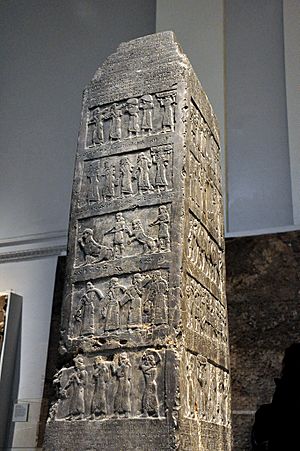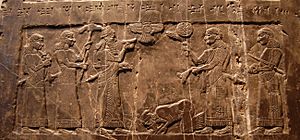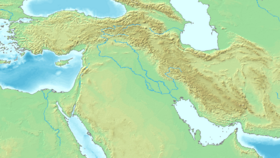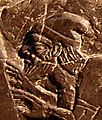Black Obelisk of Shalmaneser III facts for kids
Quick facts for kids Black Obelisk of Shalmaneser III |
|
|---|---|

The Black Obelisk of Shalmaneser III at the British Museum. Next to it is the White Obelisk of Ashurnasirpal I.
|
|
| Material | black limestone |
| Size | about 1.98 meters high, 45 cm wide |
| Writing | Akkadian |
| Created | 827–824 BC |
| Discovered | Nimrud, Iraq 36°05′53″N 43°19′44″E / 36.09806°N 43.32889°E |
| Present location | British Museum, London |
| Registration | ME 118885 |
|
Location in Near East
|
|
The Black Obelisk of Shalmaneser III is a very old stone monument from ancient Assyria. It is made of black limestone and has many carved pictures called bas-reliefs, along with writing. This amazing artifact was found in Nimrud (an ancient city in northern Iraq). It tells us about the achievements of King Shalmaneser III, who ruled from 858 to 824 BC. Today, you can see the original obelisk at the British Museum in London. Many other museums have copies of it.
This obelisk is special because it is one of only two complete ancient Assyrian obelisks ever found. Historians believe it shows the oldest picture of a person mentioned in the Bible: Jehu, who was a king of Israel. It also has the first known mention of the Parsua people, who later became known as the Persians. The obelisk shows different kings bringing gifts, called tribute, to King Shalmaneser III. It was set up in 825 BC in the main square of Nimrud during a time of civil war. An archaeologist named Sir Austen Henry Layard discovered it in 1846.
Contents
What the Obelisk Shows
The Black Obelisk has twenty carved scenes, with five on each of its four sides. These scenes show five different kings who were defeated by Assyria. They are shown bringing gifts and bowing down to the powerful Neo-Assyrian king.
From the top to the bottom, these kings are:
- Sua from Gilzanu (a region in what is now north-west Iran)
- "Yaua of Bit Omri" (who is believed to be Jehu, King of Israel)
- A ruler from Musri (a region in northern Iraq), whose name is not mentioned
- Marduk-apil-usur from Suhi (a region along the middle Euphrates River)
- Qalparunda from Patin (a region near modern-day Antakya in Turkey)
Each of these scenes covers four panels around the monument. Above each scene, there is writing in cuneiform script that explains what is happening. Cuneiform was an ancient way of writing using wedge-shaped marks.
At the very top and bottom of the carved pictures, there is a long cuneiform inscription. This writing records the "annals" (like a yearly diary) of King Shalmaneser III. It lists all the military campaigns that the king and his main general led every year for 31 years. Some experts think that the general, Dayyan-Assur, might have been the one who ordered this obelisk to be made.
King Jehu of Israel on the Obelisk

The second set of carvings from the top is very important. Many historians and archaeologists believe it shows the oldest surviving picture of a person mentioned in the Bible. The name written in the cuneiform script is mIa-ú-a mar mHu-um-ri-i.
In 1850, a scholar named Sir Henry Rawlinson first translated this inscription. He noted that the gifts were from "Yahua, son of Hubiri." A year later, in 1851, Reverend Edward Hincks made an exciting connection. He realized that "Yahua, son of Omri" likely referred to Jehu, King of Israel, from the Bible. This idea was published and is now widely accepted by experts who study the Bible and ancient history.
While some scholars, like George Smith and later P. Kyle McCarter and Edwin R. Thiele, questioned this identification, the general agreement among biblical archaeologists is that "Yaw, son of Omri" refers to the biblical King Jehu of Israel. The term "son of Omri" or "House of Omri" likely meant "from the kingdom of Omri" or "from the land ruled by Omri's dynasty."
The stone monument tells us that Jehu brought or sent his tribute to Shalmaneser III around 841 BC. The writing above the scene, in Assyrian cuneiform, says:
“I received the tribute of Iaua (Jehu) son of (the people of the land of) Omri (Akkadian: 𒅀𒌑𒀀 𒈥 𒄷𒌝𒊑𒄿): silver, gold, a golden bowl, a golden vase with pointed bottom, golden tumblers, golden buckets, tin, a staff for a king [and] spears."
Where to See Copies of the Obelisk
Since the original Black Obelisk is in the British Museum, many other places have made copies, called replicas, so more people can see and learn about it.
You can find these replicas at:
- The Oriental Institute in Chicago, Illinois
- Harvard's Museum of the Ancient Near East in Cambridge, Massachusetts
- The ICOR Library in the Semitic Department at The Catholic University of America in Washington, D.C.
- Corban University's Prewitt–Allen Archaeological Museum in Salem, Oregon
- The Siegfried H. Horn Museum at Andrews University in Berrien Springs, MI
- Kelso Museum of Near Eastern Archaeology in Pittsburgh, PA
- Canterbury Museum in Christchurch, New Zealand
- The Museum of Ancient Art at Aarhaus University in Denmark
- The library of the Theological University of the Reformed Churches in Kampen, the Netherlands
Images for kids
-
The four illustrated faces of the Black Obelisk. The second row of reliefs illustrates the Israelite delegation of King Jehu.
-
Jehu on the Black Obelisk of Shalmaneser III. This is "the only portrayal we have in ancient Near Eastern art of an Israelite or Judaean monarch".
Learn More
- Kurkh Monoliths
- List of artifacts significant to the Bible






